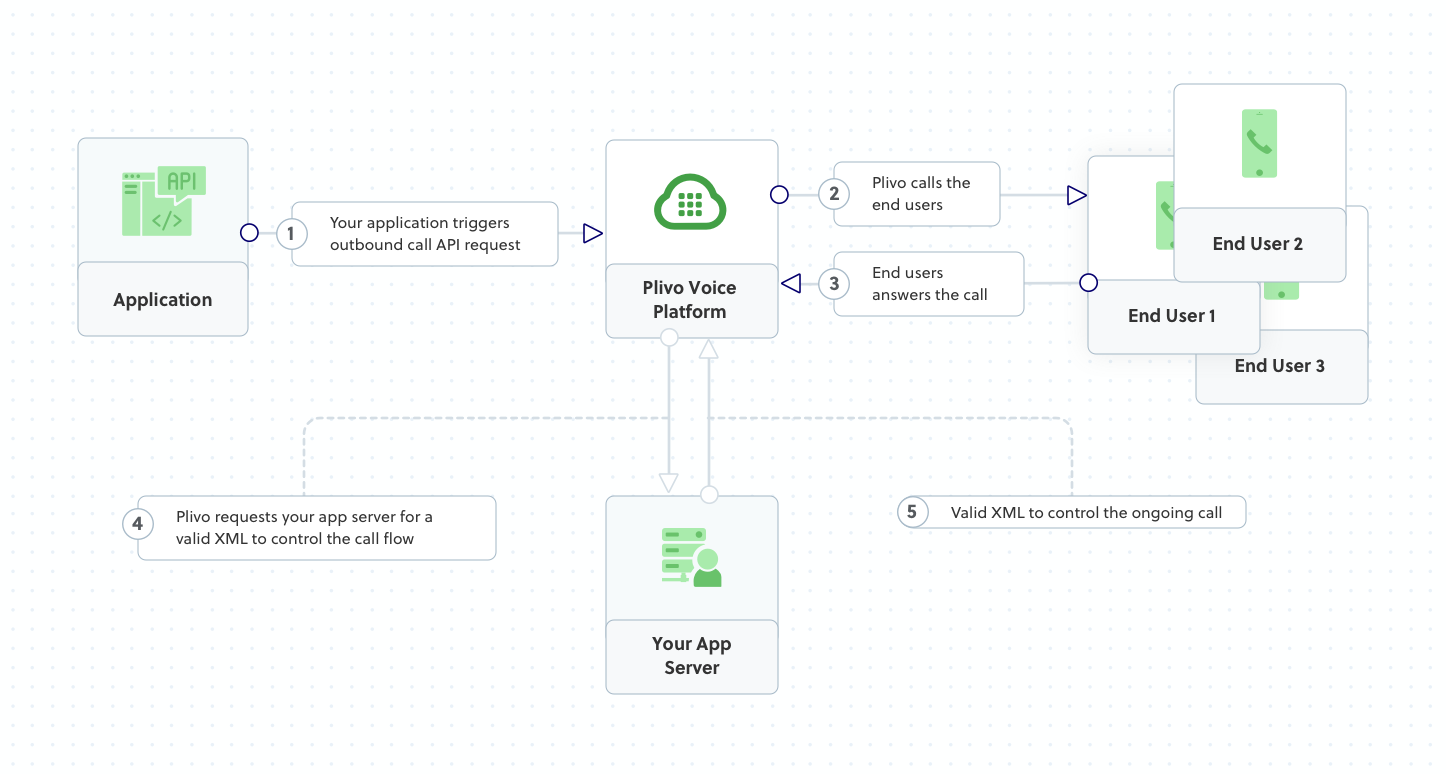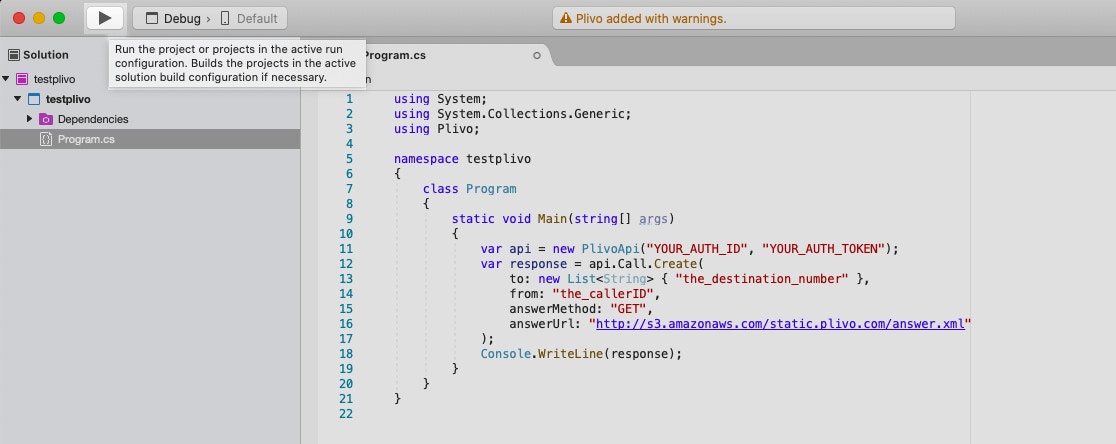- Node
- Ruby
- Python
- PHP
- .NET
- Java
- Go
Overview
This guide shows how to broadcast voice messages to multiple recipients at once. You can play recorded audio when the call recipient answers or use text-to-speech, as we show here.You can use voice broadcasting for use cases such as:- Bulk voice calling campaigns
- Emergency notifications
- Survey campaigns
- User feedback
- Announcements
- Promotions and special deals
- Reminder campaigns
- Using XML
Here’s how to broadcast voice alerts and notifications using XML.
How it works

Copy
Ask AI
<Response>
<Speak>Congratulations! You have made your first bulk call.</Speak>
</Response>
Prerequisites
To get started, you need a Plivo account — sign up with your work email address if you don’t have one already. If this is your first time using Plivo APIs, follow our instructions to set up a Node.js development environment and a web server and safely expose that server to the internet.Create voice alert broadcast application
Create a file calledBroadcast.js and paste into it this code.Copy
Ask AI
var plivo = require('plivo');
(function main() {
'use strict';
var client = new plivo.Client("<auth_id>","<auth_token>");
client.calls.create(
"<caller_id>", // from
"destination_number1<destination_number2", // to
"https://s3.amazonaws.com/static.plivo.com/broadcast.xml", // answer url
{
answerMethod: "GET",
},
).then(function (response) {
console.log(response);
}, function (err) {
console.error(err);
});
})();
Note: We recommend that you store your credentials in the
auth_id and auth_token environment variables, so as to avoid the possibility of accidentally committing them to source control. If you do this, you can initialize the client with no arguments and it will automatically fetch them from the environment variables. You can use process.env to store environment variables and fetch them when initializing the client.Test
Save the file and run it.Copy
Ask AI
node Broadcast.js
Overview
This guide shows how to broadcast voice messages to multiple recipients at once. You can play recorded audio when the call recipient answers or use text-to-speech, as we show here.You can use voice broadcasting for use cases such as:- Bulk voice calling campaigns
- Emergency notifications
- Survey campaigns
- User feedback
- Announcements
- Promotions and special deals
- Reminder campaigns
- Using XML
Here’s how to broadcast voice alerts and notifications using XML.
How it works

Copy
Ask AI
<Response>
<Speak>Congratulations! You have made your first bulk call.</Speak>
</Response>
Prerequisites
To get started, you need a Plivo account — sign up with your work email address if you don’t have one already. If this is your first time using Plivo APIs, follow our instructions to set up a Ruby development environment and a web server and safely expose that server to the internet.Create voice alert broadcast application
Create a file calledbroadcast.rb and paste into it this code.Copy
Ask AI
require 'rubygems'
require 'plivo'
include Plivo
include Plivo::Exceptions
api = RestClient.new("<auth_id>","<auth_token>")
begin
response = api.calls.create(
'<caller_id>',
['<destination_number1>', '<destination_number2>'],
'https://s3.amazonaws.com/static.plivo.com/broadcast.xml'
)
puts response
rescue PlivoRESTError => e
puts 'Exception: ' + e.message
end
Note: We recommend that you store your credentials in the
auth_id and auth_token environment variables, so as to avoid the possibility of accidentally committing them to source control. If you do this, you can initialize the client with no arguments and it will automatically fetch them from the environment variables. You can use ENV to store environment variables and fetch them when initializing the client.Test
Save the file and run it.Copy
Ask AI
ruby broadcast.rb
Overview
This guide shows how to broadcast voice messages to multiple recipients at once. You can play recorded audio when the call recipient answers or use text-to-speech, as we show here.You can use voice broadcasting for use cases such as:- Bulk voice calling campaigns
- Emergency notifications
- Survey campaigns
- User feedback
- Announcements
- Promotions and special deals
- Reminder campaigns
- Using XML
Here’s how to broadcast voice alerts and notifications using XML.
How it works

Copy
Ask AI
<Response>
<Speak>Congratulations! You have made your first bulk call.</Speak>
</Response>
Prerequisites
To get started, you need a Plivo account — sign up with your work email address if you don’t have one already. If this is your first time using Plivo APIs, follow our instructions to set up a Ruby development environment and a web server and safely expose that server to the internet.Create voice alert broadcast application
Create a file calledbroadcast.py and paste into it this code.Copy
Ask AI
import plivo
client = plivo.RestClient('<auth_id>','<auth_token>')
response = client.calls.create(
from='<caller_id>',
to='destination_number1<destination_number2',
answer_url='https://s3.amazonaws.com/static.plivo.com/broadcast.xml',
answer_method='GET', )
print(response)
Note: We recommend that you store your credentials in the
auth_id and auth_token environment variables, so as to avoid the possibility of accidentally committing them to source control. If you do this, you can initialize the client with no arguments and it will automatically fetch them from the environment variables. You can use os module(os.environ) to store environment variables and fetch them when initializing the client.Test
Save the file and run it.Copy
Ask AI
python broadcast.py
Overview
This guide shows how to broadcast voice messages to multiple recipients at once. You can play recorded audio when the call recipient answers or use text-to-speech, as we show here.You can use voice broadcasting for use cases such as:- Bulk voice calling campaigns
- Emergency notifications
- Survey campaigns
- User feedback
- Announcements
- Promotions and special deals
- Reminder campaigns
- Using XML
Here’s how to broadcast voice alerts and notifications using XML.
How it works

Copy
Ask AI
<Response>
<Speak>Congratulations! You have made your first bulk call.</Speak>
</Response>
Prerequisites
To get started, you need a Plivo account — sign up with your work email address if you don’t have one already. If this is your first time using Plivo APIs, follow our instructions to set up a Ruby development environment and a web server and safely expose that server to the internet.Create voice alert broadcast application
Create a file calledbroadcast.py and paste into it this code.Copy
Ask AI
import plivo
client = plivo.RestClient('<auth_id>','<auth_token>')
response = client.calls.create(
from='<caller_id>',
to='destination_number1<destination_number2',
answer_url='https://s3.amazonaws.com/static.plivo.com/broadcast.xml',
answer_method='GET', )
print(response)
Note: We recommend that you store your credentials in the
auth_id and auth_token environment variables, so as to avoid the possibility of accidentally committing them to source control. If you do this, you can initialize the client with no arguments and it will automatically fetch them from the environment variables. You can use $_ENV or putenv/getenv to store environment variables and fetch them when initializing the client.Test
Save the file and run it.Copy
Ask AI
php Broadcast.php
Overview
This guide shows how to broadcast voice messages to multiple recipients at once. You can play recorded audio when the call recipient answers or use text-to-speech, as we show here.You can use voice broadcasting for use cases such as:- Bulk voice calling campaigns
- Emergency notifications
- Survey campaigns
- User feedback
- Announcements
- Promotions and special deals
- Reminder campaigns
- Using XML
Here’s how to broadcast voice alerts and notifications using XML.

How it works

Copy
Ask AI
<Response>
<Speak>Congratulations! You have made your first bulk call.</Speak>
</Response>
Prerequisites
To get started, you need a Plivo account — sign up with your work email address if you don’t have one already. If this is your first time using Plivo APIs, follow our instructions to set up a Ruby development environment and a web server and safely expose that server to the internet.Create voice alert broadcast application
In Visual Studio, open the file in the CS project calledProgram.cs and paste into it this code.Copy
Ask AI
using System;
using System.Collections.Generic;
using Plivo;
namespace testplivo
{
class Program
{
static void Main(string[] args)
{
var api = new PlivoApi("<auth_id>","<auth_token>");
var response = api.Call.Create(
to: new List<String> { "<destination_number1>", "<destination_number2>" },
from: "<caller_id>",
answerMethod: "GET",
answerUrl: "https://s3.amazonaws.com/static.plivo.com/broadcast.xml"
);
Console.WriteLine(response);
}
}
}
Note: We recommend that you store your credentials in the
auth_id and auth_token environment variables, so as to avoid the possibility of accidentally committing them to source control. If you do this, you can initialize the client with no arguments and it will automatically fetch them from the environment variables. You can use Environment.SetEnvironmentVariable Method to store environment variables and Environment.GetEnvironmentVariable Method to fetch them when initializing the client.Test
Save the file and run it.
Overview
This guide shows how to broadcast voice messages to multiple recipients at once. You can play recorded audio when the call recipient answers or use text-to-speech, as we show here.You can use voice broadcasting for use cases such as:- Bulk voice calling campaigns
- Emergency notifications
- Survey campaigns
- User feedback
- Announcements
- Promotions and special deals
- Reminder campaigns
- Using XML
Here’s how to broadcast voice alerts and notifications using XML.

How it works

Copy
Ask AI
<Response>
<Speak>Congratulations! You have made your first bulk call.</Speak>
</Response>
Prerequisites
To get started, you need a Plivo account — sign up with your work email address if you don’t have one already. If this is your first time using Plivo APIs, follow our instructions to set up a Ruby development environment and a web server and safely expose that server to the internet.Create voice alert broadcast application
Create a Java class in the project calledBroadcast and paste into it this code.Copy
Ask AI
import java.io.IOException;
import java.util.Collections;
import com.plivo.api.Plivo;
import com.plivo.api.exceptions.PlivoRestException;
import com.plivo.api.models.call.Call;
import com.plivo.api.models.call.CallCreateResponse;
class MakeCall {
public static void main(String [] args) throws IOException, PlivoRestException {
Plivo.init("<auth_id>","<auth_token>");
CallCreateResponse response = Call.creator("<caller_id>",
Collections.singletonList("<destination_number1>", "<destination_number2>"),
"https://s3.amazonaws.com/static.plivo.com/broadcast.xml")
.answerMethod("GET")
.create();
System.out.println(response);
}
}
Note: We recommend that you store your credentials in the
auth_id and auth_token environment variables, so as to avoid the possibility of accidentally committing them to source control. If you do this, you can initialize the client with no arguments and it will automatically fetch them from the environment variables. You can use System.getenv() to store environment variables and retrieve them when initializing the client.Test
Save the file and run it.
Overview
This guide shows how to broadcast voice messages to multiple recipients at once. You can play recorded audio when the call recipient answers or use text-to-speech, as we show here.You can use voice broadcasting for use cases such as:- Bulk voice calling campaigns
- Emergency notifications
- Survey campaigns
- User feedback
- Announcements
- Promotions and special deals
- Reminder campaigns
- Using XML
Here’s how to broadcast voice alerts and notifications using XML.
How it works

Copy
Ask AI
<Response>
<Speak>Congratulations! You have made your first bulk call.</Speak>
</Response>
Prerequisites
To get started, you need a Plivo account — sign up with your work email address if you don’t have one already. If this is your first time using Plivo APIs, follow our instructions to set up a Ruby development environment and a web server and safely expose that server to the internet.Create voice alert broadcast application
Create a file calledBroadcast.go and paste into it this code:Copy
Ask AI
package main
import "fmt"
import "github.com/plivo/plivo-go/v7"
func main() {
client, err := plivo.NewClient("<auth_id>","<auth_token>", &plivo.ClientOptions{})
if err != nil {
fmt.Print("Error", err.Error())
return
}
response, err := client.Calls.Create(
plivo.CallCreateParams{
From: "<caller_id>",
To: "destination_number1<destination_number2",
AnswerURL: "https://s3.amazonaws.com/static.plivo.com/broadcast.xml",
AnswerMethod: "GET",
},
)
if err != nil {
fmt.Print("Error", err.Error())
return
}
fmt.Printf("Response: %#v\n", response)
}
Note: We recommend that you store your credentials in the
auth_id and auth_token environment variables, so as to avoid the possibility of accidentally committing them to source control. If you do this, you can initialize the client with no arguments and it will automatically fetch them from the environment variables. You can use os.Setenv and os.Getenv to store environment variables and fetch them when initializing the client.Test
Save the file and run it.Copy
Ask AI
go run Broadcast.go